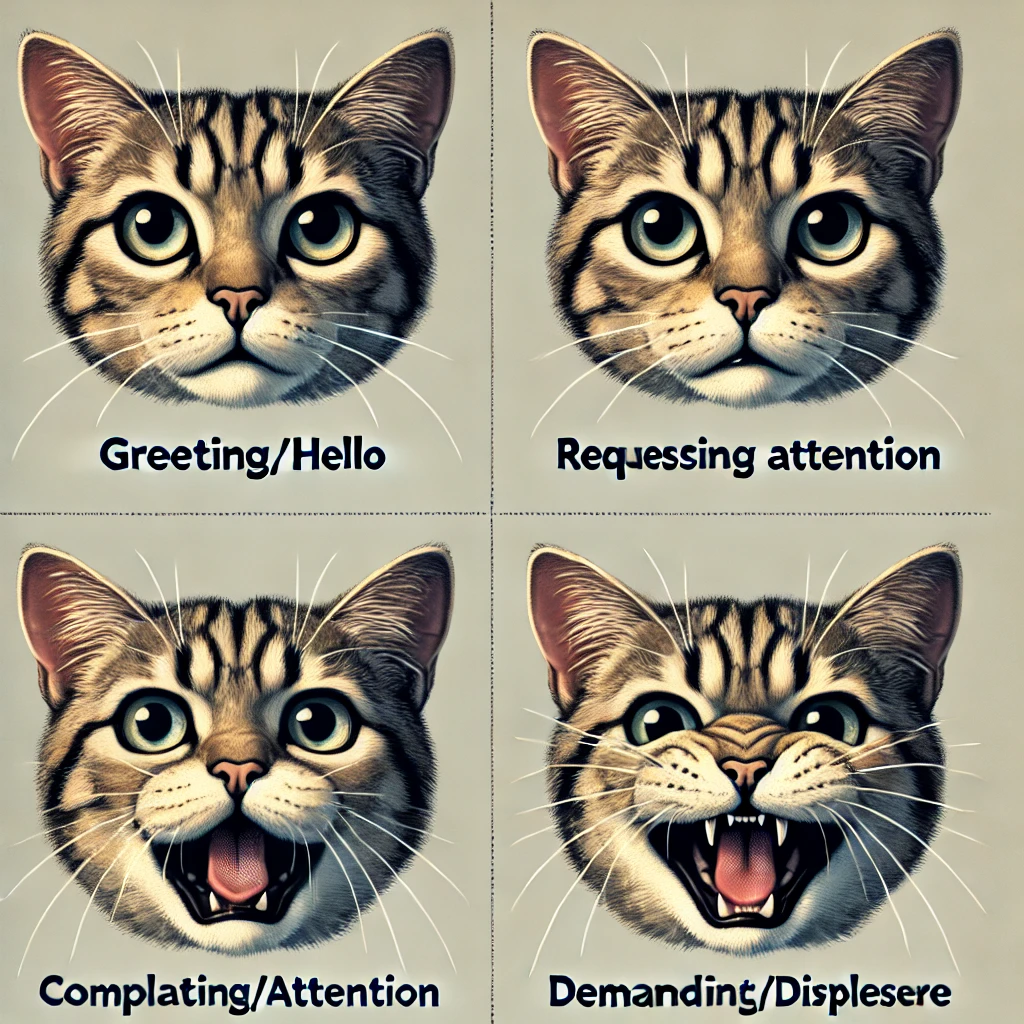Unlock the secrets of your cat’s meows to strengthen your bond and meet their needs effectively.
Introduction
Have you ever wondered what your cat is trying to tell you with their various meows? Cats are more vocal than many people realize, and each meow can carry a different meaning. By understanding cat meows, you can better meet your feline friend’s needs and deepen your relationship. In this guide, we’ll explore the diversity of meows in cat communication, what different meows signify, and how you can respond appropriately.
The Diversity of Meows in Cat Communication
Cats use meowing primarily to communicate with humans. While kittens meow to get attention from their mothers, adult cats often meow to interact with us. The nuances in pitch, duration, and frequency can convey a wide range of messages, from a simple greeting to urgent requests.
Why Cats Meow
- Attention Seeking: Cats may meow to get your attention for playtime, petting, or simply companionship.
- Expressing Needs: Hunger, thirst, or a desire to go outside can prompt specific meows.
- Emotional Expression: Feelings of discomfort, stress, or excitement can influence their vocalizations.
- Medical Issues: Excessive or unusual meowing can sometimes indicate health problems.
Understanding these vocal cues can help you respond appropriately and ensure your cat’s well-being.
Types of Meows and Their Common Meanings
Short Meow
- Meaning: A standard greeting or acknowledgment.
- When You Might Hear It: When you walk into a room or arrive home.
- How to Respond: Acknowledge your cat with a gentle pet or verbal greeting.
Multiple Meows
- Meaning: Excitement or eagerness.
- When You Might Hear It: Around feeding times or when preparing a favorite activity.
- How to Respond: Engage with your cat, providing food or initiating playtime.
Mid-Pitch Meow
- Meaning: A polite request for something.
- When You Might Hear It: When they want to be let outside or need help reaching something.
- How to Respond: Assess their need and assist if appropriate.
Drawn-Out Meow
- Meaning: A demand or insistence.
- When You Might Hear It: If you’re not responding quickly enough to their request.
- How to Respond: Attend to their need promptly, if reasonable.
Low-Pitch Meow
- Meaning: Complaint or unhappiness.
- When You Might Hear It: During a delayed meal or if they’re confined.
- How to Respond: Address the issue causing discomfort.
High-Pitch Meow
- Meaning: Pain or sudden distress.
- When You Might Hear It: If you accidentally step on their tail or they encounter something unpleasant.
- How to Respond: Check for injuries and offer comfort.
Chirps and Trills
- Meaning: Friendly greeting or attention-getter.
- When You Might Hear It: When they want you to follow them or look at something.
- How to Respond: Follow your cat to see what they want to show you.
Yowling
- Meaning: Distress, mating call, or territorial issues.
- When You Might Hear It: From unneutered cats or during conflicts with other animals.
- How to Respond: Consider spaying or neutering your cat and ensure their environment is secure.
Growling or Hissing
- Meaning: Aggression or fear.
- When You Might Hear It: When they feel threatened.
- How to Respond: Give them space and remove any perceived threats.
How Pitch and Duration Affect the Message
The pitch and duration of a meow can significantly alter its meaning.
Pitch
- High-Pitched Meows: Often indicate happiness or excitement.
- Low-Pitched Meows: Usually express dissatisfaction or a serious request.
Duration
- Short Meows: Simple greetings or acknowledgments.
- Long, Drawn-Out Meows: Stronger demands or complaints.
Repetition
- Frequent Meowing: Increased urgency or excitement.
- Continuous Meowing: May indicate distress or medical issues.
By paying attention to these nuances, you can better interpret what your cat is trying to convey.
Tips for Responding to Different Meows
Observe the Context
- Environment: Is it near feeding time? Has something changed in their surroundings?
- Body Language: Tail position, ear orientation, and eye contact can provide additional clues.
- Time of Day: Some cats are more vocal at certain times, like dawn or dusk.
Consistent Responses
- Positive Reinforcement: Reward desirable behaviors with attention or treats.
- Avoid Reinforcing Negative Behaviors: Don’t give in to demands if they meow excessively for unnecessary reasons.
Consult a Veterinarian
- Behavioral Changes: Sudden increases in vocalization may indicate health issues.
- Senior Cats: Older cats may meow more due to cognitive decline or sensory deficits.
Enrich Their Environment
- Interactive Toys: Keep them engaged to reduce attention-seeking meows.
- Regular Playtime: Helps expend energy and reduces boredom.
- Safe Spaces: Provide areas where they can retreat and feel secure.
Explore engaging toys for your cat
Conclusion
Interpreting your cat’s meows is a rewarding way to strengthen your bond and ensure their needs are met. By understanding the different types of meows and what they signify, you can communicate more effectively with your feline companion. Remember, each cat is unique, so take the time to learn your cat’s specific vocal patterns. With patience and observation, you’ll become fluent in your cat’s language, leading to a happier and more harmonious relationship.






